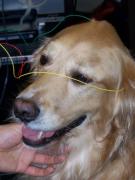What Do Pongo and Perdita Have to Do with Deafness in Dogs and Cats?

What Do Pongo and Perdita Have to Do with Deafness in Dogs and Cats?
The image on the right, is of Pongo, Perdita and their family, the iconic Dalmatians from the classic Disney movie, 101 Dalmatians. Yes, it is one of my childhood favorites, but the image is here because today I am writing about hearing loss in dogs and cats, and Dalmatians are the breed most commonly associated with an inherited form of deafness. Inherited deafness is just one type of hearing loss. Medically, veterinarians use several different classification schemes to categorize hearing loss in pets.
Inherited or Acquired Deafness
Inherited means hearing loss is due to abnormalities in the genetic material coding for hearing. In dogs, inherited deafness is associated with white haircoats, piebald (spotted) haircoats like the Dalmatian, or merle (dappled) haircoats like the Australian Shepherd. Most inherited hearing loss becomes obvious at just a few weeks of age. Acquired deafness occurs because a disease or medication destroys hearing function or because of normal aging.
Sensorineural or Conductive
While these words may not be familiar to many of my readers, the explanation of the words is quite easy to understand. In order for sound to be conducted from the ear to the brain, sound must get into the ears. Either a bad ear infection (a really common cause of hearing loss in dogs and cats) or a tumor or the ear canal (a much less common cause of hearing loss) can obstruct the ear canal. Both conditions result in conductive deafness. Sensorineural deafness results from dysfunction of the hearing structures of the ear, nerve damage to the auditory nerve or a problem in the brain’s ability to perceive sound. Sensorineural deafness is the common form of hearing loss in older animals.
Congenital or Late Onset
Congenital deafness is a condition present at birth. The majority of white cats with two blue eyes are born deaf. Less than half of white cats with one blue eye are deaf and they are usually deaf on the side with the blue eye. If we use all the classification schemes together, white cats with blue eyes have inherited congenital sensorineural deafness.
If you have an older dog who has had multiple bad ear infections and can no longer hear well, he probably has acquired late onset conductive deafness.
Hearing Tests in Pets
The Animal Medical Center’s Neurology Service uses a test called the brainstem auditory evoked response (BAER) to diagnose hearing loss in pets. The BAER machine measures brainwaves in response sound using electrodes attached to the skin.
Alterations in brainwaves indicate conductive or sensorineural deafness. BAER can be used to identify congenital deafness in puppies and kittens and exclude them from breeding programs.
Treatments for Deafness in Pets
If hearing loss is caused by an ear infection, treatment may restore hearing. Pet owners often ask about hearing aids for dogs. For pets with congenital deafness like the Dalmatian or white, blue-eyed cats, hearing aids will be of no benefit as hearing aids amplify sound, but this type of hearing loss cannot detect any sound at all, even really loud sounds. The use of hearing aids has been tried in dogs with limited success. Dogs are not always cooperative with devices placed in their ears. Many dogs (and cats) acclimate to their hearing loss. Since smell is a dog’s most highly developed sense, deaf dogs and cats can function well as indoor pets.
Further Reading
- Read this incredible story of how Sparky, a deaf Dachshund, learned sign language and helped deaf children at their special school.
- Resources for Deaf Pets

































